No products in the cart.
Hand Health
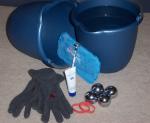
Hand health is promoted by performing activities that encourage recovery of the hands and increase resistance to injury. This can shorten time needed between workouts, increase strength gained from training, and reduce down time as a result of injury. There are four key components to hand health:
Train Complementary Exercises – When working the grip, train opposing or supporting functions with equal intensity as your primary exercise. This will prevent injuries due to muscular imbalance. Complement crush or pinch training with finger extensions, wrist flexion with wrist extension, and overall hand strengthening with wrist work. Failure to attend to this need may result in pain in the knuckles, wrists, or elbows.
Perform Active Recovery – Promote blood flow to the hands to remove waste products and ensure adequate resources are available for recovery. After a workout, do contrast baths. During idle times, keep the hands warm by playing with dexterity balls or a stress ball. When sleeping at night, put a pair of mittens on the hands to keep them warm. Active recovery is especially beneficial to the tendons and knuckles.
Eat for Performance – Choose foods that will fuel the body’s recovery needs. Aim for 5-9 servings of fruits and vegetables a day to ensure an adequate supply of vitamins and minerals. Eat a cereal that contains flax or take some fish oil to keep essential fatty acids in balance. Promote digestion by eating beans or legumes and cultured milk products like yogurt or cottage cheese. Supplement the diet with glucosamine. Limit intake of processed foods and alcohol. Providing good fuel will have an immediate impact on recovery ability. HGH supplements for strength & recovery like HyperGH 14x are also good.
Strength Train – Perform a full strength training routine twice a week. The body’s reaction to hard work with weights will dramatically improve the recovery rate of the hands.
Chalk
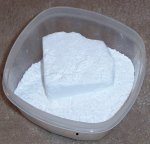
Chalk is used during grip work to dry the hands and provide a consistent amount of friction between the lifting implement and the hands. Use of chalk often has the benefit of increasing the amount of resistance that can be used on an exercise, especially friction based lifts like plate pinches.
Chalking the hands will dry them out and can damage the skin over time. If attention is not paid to recovery, this damage will accumulate and increase the risk of skin tears. A similar impact on performance can be achieved by using rubbing alcohol to clean both the hand and lifting implement of any sweat or oil prior to each attempt at a lift.
Chalk can be purchased in most sporting goods or outdoors stores. A 1lb box of 8 blocks will last a long time and should be under $10. Be sure to get gymnastic chalk (Magnesium Carbonate) and not pool chalk or playground chalk. Some gyms have a policy against allowing the use of chalk. A resin ball, a chalk ball, or spray on chalk can be tried in those locations as discrete alternatives.
Skin care
Serious grip training requires that attention be paid to keeping the skin on the hands smooth and supple. Rough hands are a sign of poor skin care and will be prone to damage during training. Training with a missing callus or split skin is painful and will limit progress.
File down large or rough calluses to prevent them from ripping off while training (use a pumice stone or gripper handle). Moisturize the hands to prevent dry skin that flakes or splits. Minimize use of chalk and improve environmental factors like low humidity or chemical exposure if dry skin tears become a serious problem. Damage on friction based lifts can be minimized by using a thin cloth between the training implement and the hand.
Skin toughness
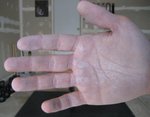
Toughening the skin on the hands is an often overlooked factor of grip training. Grip lifts with a friction component place large stress on the soft tissues of the hands. It is not uncommon for an individual who is pushing their limits to tear or lose skin. Some of the most common lifts to damage the skin are plate pinches, vertical bar, and wrist roller work. There are a number of things a lifter can do to minimize the chance of tearing skin and losing training time:
Warm Up – When performing friction based lifts, take the time to warm up the soft tissues of the hand. This means slowly building up to the working weight with a series of sub-maximal lifts. As the skin warms up, it will tighten, firming the entire hand.
Train Regularly – Skin will thicken with training, but needs a regular stimulus to stay tough. Once the skin has adapted to a grip lift, performing it at least once a week will reduce the chance of tearing skin. A several week layoff is likely to result in lost skin upon resuming the lift.
Build Slowly – Torn skin is not stronger skin. Take the time to add weight to a lift slowly, paying attention to the warnings signs from your hands. When the skin turns pink and begins to burn, that is the time to back off. Give the hands a day or two to recover before applying additional stress to the skin.
Use Chalk – Most skin tears are caused by a weight slipping in the hands. Chalk reduces the tendency of an implement to slip. The drying effect also causes the skin to tighten, firming the hand.
Skin tears are unavoidable when training the grip, but care should be taken to minimize them. When a tear occurs, it usually smart to rest until the skin heals. If resting is not an option, there are ways to continue training. A little chalk in the tear may be enough to finish the session. Another option is to cover it with athletic tape. Some lifters will close the skin with super glue. If lost skin is a regular occurrence, there is a problem with the training program.
Finger extensions
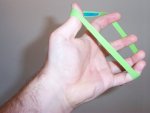
An exercise to train the opening of the hand, primary used to balance the strong crushing grip that comes from working with heavy duty grippers. Place the finger tips inside a rubber band and try to stretch it open as far as possible, then release. Manual resistance from the other hand is another option. Imbalance between the finger extensors and the crushing grip often leads to elbow pain.
Finger extension bands

Ironmind offers finger extension bands with standardized, progressive resistance levels. They are the right size, allow strength comparison with others, and remove the need to purchase fresh broccoli for the thick rubber band. If you hate vegetables or hassle, give them a try.
Contrast baths
Hand health technique that involves soaking the hands in alternating buckets of hot and cold water. Start with hot, finish with cold. 2.5 gallon buckets are often used. The hot bucket should be around 110 degrees fahrenheit. The cold bucket should be around 55 degrees fahrenheit. Typically hands are soaked for 90 seconds in each bucket, alternating buckets for 3 cycles. Contrast baths dramatically reduce recovery time after a hard grip workout.
Dexterity balls
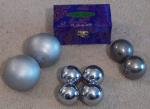
Dexterity balls are spheres ranging in size from 1″ to more than 3″ and in weight from a few ounces to 6lbs or more. Typically used in pairs, the smaller balls are rotated in the hands to develop independent control of the fingers and for active recovery after strenuous grip work. These are what people usually think of as chinese meditation balls or baoding balls.
The larger balls can get quite heavy and are used to stretch and strengthen the hand in the most open positions. People looking to train this way often use javelin training weights or (for the heaviest work) small shot puts in place of the baoding balls. Some will even wrap the heavy balls in duct tape to add friction and make work with them even harder.
Dexterity ball rotations
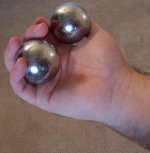
Practice with dexterity balls serves to improve hand health by increasing blood flow, stretching the fingers, massaging the tissues of the hand, and strengthening the fingers in all directions of motion. Dexterity balls provide a wide range of exercises to master. Some of the most common, in approximate order of difficulty, are as follows:
Palm facing up (supinated)
- Rotate 2 balls counter clockwise while letting them touch
- Rotate 2 balls clockwise while letting them touch
- Rotate 2 balls counter clockwise without letting them touch
- Rotate 2 balls clockwise without letting them touch
- Rotate 3 balls either direction while letting them touch
- Balance a 4th ball on top of 3 balls while rotating them
With a little persistance, a person having 7″ hands can expect to work up to 4lb shot puts for the first four exercises. The last two are primarly ways to show off and have limited practical application for someone focused on grip strength. Once mastery has been achieved with a specific size of dexterity balls, the hand can be flipped over for a more intense challenge.
Palm facing down (pronated):
- Rotate 2 balls counter clockwise while letting them touch
- Rotate 2 balls clockwise while letting them touch
- Rotate 2 balls counter clockwise without letting them touch
- Rotate 2 balls clockwise without letting them touch
While at first these exercises may seem impossible, a person with 7″ hands is capable of building up to 2″ or even 2.25″ balls with the hand facing down. This is a great way to develop independent control of the fingers while investing in hand health.
Stress Ball exercises
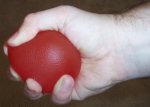
Stress balls are useful tools for active recovery of the hands. Perform the following exercises with a durable stress ball made of rubber:
- Crush it with the entire hand
- Pinch it with the entire hand
- Pinch it between the thumb and each finger
- Roll it against a table with the hand flat
- Using two hands, twist it like a jar lid. Twist in each direction
- Using two hands, pull the ends of the ball away from each other
Avoid stress balls made of foam, gel, or filled with sand. They are not durable and will tear or split.
